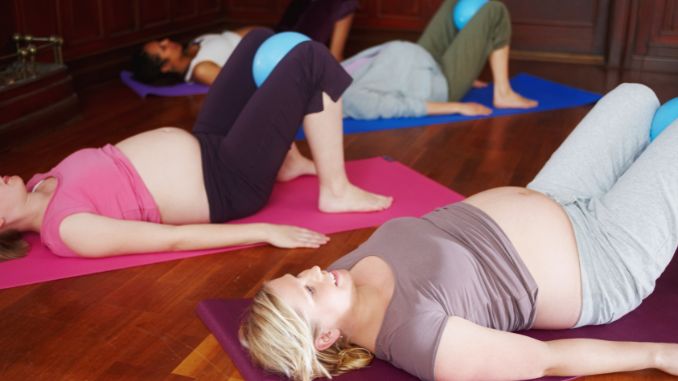Congratulations! Pregnancy is a wonderful and exciting time, but it can also be difficult, both on a physical and psychological level. A safe and effective pregnancy workout plan can help make it easier, as it can assist in reducing stress, improving mood, and keeping your body strong and healthy. Studies show that exercising can help avoid gestational diabetes, lessen pregnancy complications, and give you the strength you need for childbirth. Aside from these, working out regularly while expecting can help you stay in better shape, reduce back pain and reduce tiredness.
Constructing a Plan that Perfectly Fits You
The most important factor when planning a successful pregnancy workout routine is what works best for you. Your program should reflect your condition, fitness level, and pre-existing medical issues to aid pregnancy symptoms. Contacting a doctor before beginning any physical activity is wise to ensure safety and obtain approval.
Additionally, ensure your plan is achievable; attempt only a little at once. Establishing achievable goals can motivate you and give you something to strive for. When you have the ideal plan, pick which workouts you’ll do; there are many different activities you can do while pregnant, such as walking, swimming, and yoga.
Ensure the exercises you select are appropriate for your fitness level and that you enjoy them; this will help to keep you motivated.
Factors to consider when creating a pregnancy workout plan
When constructing a pregnancy workout plan, there are several factors to ensure both the safety of the mother and the developing baby. It’s important to choose exercises that do not strain the body excessively, avoid activities with a risk of falling or impact, and stay hydrated throughout the workout. Also, before starting any new exercise routine, it’s always advisable to consult with a healthcare provider. These elements include:
Consultation with a healthcare provider
Consulting your doctor before starting a pregnancy workout plan. This is crucial because it ensures you and your baby are healthy and safe during the workout.
Your doctor can provide personalized recommendations based on your specific health conditions and the stage of your pregnancy. They can advise you on any modifications you may need to make to your exercise routine to accommodate the changes in your body during pregnancy.
As we’ve said, the safety and well-being of you and your baby are the top priority of the pregnancy workout plan, and your doctor is the best person to guide you in achieving this.
Trimester-specific guidelines
It is important to consider trimester-specific guidelines when planning a workout during pregnancy as the body goes through various changes during this period.
During the first trimester, low-impact exercises such as walking, swimming, and prenatal yoga can be performed while avoiding high-impact exercises and activities that involve jumping or bouncing. As the pregnancy progresses, a few modifications may be necessary to lodge the growing baby and support overall comfort and safety. Before starting or continuing any physical activity during pregnancy, consulting with your doctor and obtaining medical clearance are recommended.
Pre-existing medical conditions
Like inherited heart diseases, pre-existing medical conditions can greatly affect the mother’s and developing fetus’ overall health and well-being during pregnancy. Considering these conditions, such as adding importance to cardio exercises when planning a pregnancy workout routine is important, as certain exercises and physical activities may be contraindicated. Failure to do so can increase the risk of complications and adverse effects on both mother and baby.
It is recommended to consult with a healthcare provider to determine the most appropriate and safe exercise plan based on personal medical history and conditions.
Other things to consider before starting a pregnancy workout plan:
Pregnancy is a time of immense physical and emotional change, and regular exercise can be an excellent way to help you manage these changes. You can do several things to prepare for exercise during pregnancy.
- Choose safe and appropriate pregnancy exercises and low-impact activities.
- Warm up and cool down before and after each workout.
- Investing in appropriate workout gear to support your body and accommodate your changing shape is crucial.
- Drinking plenty of water before, during, and after exercise is important to avoid dehydration and overheating.
- Listen to your body, and don’t push yourself too hard. Instead, focus on maintaining a regular exercise routine that feels comfortable and enjoyable.
- Always take breaks or slow down if you feel discomfort, pain, or dizziness.
Be mindful of the intensity of the pregnancy workout plan and avoid any activities that cause pain or discomfort.
Wear loose-fitting clothing and supportive shoes for comfort and stability.
By taking these steps, you can enjoy exercise’s many physical and emotional benefits during pregnancy.
Tips for Adhering to Your Pregnancy Exercises
Once you have developed an exercise program that is appropriate for you, the next step is to guarantee you adhere to it.
Here are some suggestions for keeping track and acquiring the greatest advantage from your workout routine:
- Establish attainable objectives and partition them into lesser, achievable goals.
- Pre-plan your workouts and allocate time for them.
- Get an accountability buddy or participate in an online fitness community to stay inspired.
- Honor your accomplishments, no matter how minor.
These tips ensure you stay on track with your pregnancy workout plan and reap the rewards.
Is exercise during pregnancy important?
During pregnancy, exercise can assist with common pregnancy symptoms, such as bloating, swelling, constipation, and backaches. However, taking necessary precautions to ensure safety and avoid pregnancy complications is important.
Throughout pregnancy, movement is vital for several reasons.
- It can help reduce stress, improve mood, and keep your body strong and healthy.
- help reduce back pain, tiredness, and the risk of gestational diabetes
- help you prepare for labor by strengthening your muscles and improving your endurance
Besides this, working out during pregnancy can help you lose weight after childbirth by burning calories and strengthening your core muscles.
What are exercises safe for pregnant
When it comes to exercises that are safe to do while pregnant, the best ones are:
- Low-impact aerobics such as walking, swimming, or cycling. These activities will not put too much strain on your body but will still provide some exercise benefits.
- Strength training is also a great option for pregnant women as it helps build muscle strength, benefiting them while giving birth.
- Yoga is another great option as it helps relieve stress and also helps with balance and flexibility, which can be beneficial.
The risks and benefits of a pregnancy workout plan
There are many benefits to doing a safe and effective pregnancy workout plan, but some risks should be considered.
Exercise can bring about various benefits, such as:
- alleviate any pain in your back, irregular bowel movements, stomach distention, and puffiness or inflammation
- help reduce the risk of preeclampsia and preterm labor
- increase your positivity and vitality
- aid in getting a better night’s sleep
- avoid putting on too much extra weight
- enhance your muscle tone, power, and stamina
- gradually elevating the heartbeat and circulation
While adopting a consistent exercise routine during pregnancy could bring several advantages, such as:
- helps reduce the chances of developing obesity and associated problems like gestational diabetes and high blood pressure
- reduces the possibility of requiring a cesarean delivery
- helps avoid constipation, varicose veins, and lower back pain
- staying flexible and strong
- controlling weight gain
- training the muscles
- help prevent deep vein thrombosis
- improve sleep and emotional well-being
The main risk is over-exertion, which can lead to physical injury or premature labor.
Beneficial for the baby
Yes, pregnancy workouts can help the baby in many ways. Studies show that there may also be benefits for the baby, such as:
- improved the baby’s health and development
- lower fetal heart rate
- healthier birth weight
- lower fat mass
- improved stress tolerance
- enhanced nervous system development
- helps to increase oxygen and nutrient delivery to the baby
- reduce stress hormones that can be harmful to the fetus
- help prepare the body by strengthening muscles and
- improving endurance
The best pregnancy workouts
There is no one-size-fits-all answer to this question, as the best workouts for pregnant women will vary depending on your physical condition, pregnancy stage, and if you have a high-risk pregnancy.
However, these are the best workouts if you have a healthy pregnancy.
- walking
- water aerobics
- jogging
- Pilates
- yoga
- stationary cycling
- Kegels
- low-intensity weight training
Trimester Pregnancy Workout Plan
A trimester pregnancy workout plan is a tailored fitness routine designed to help expectant mothers maintain a healthy pregnancy, alleviate common discomforts and prepare their bodies for labor and delivery. With guidance from a healthcare provider, this plan includes safe and effective exercises appropriate for each stage of pregnancy.
First Trimester Workouts
During the first trimester, focusing on low-impact, gentle exercises that don’t put too much strain on the body is important.
During the first trimester of pregnancy, recommended exercises are low-impact, such as:
- walking
- digging in the garden
- yoga
- swimming
- water aerobics
- running
- jogging
- moderate weightlifting
IMPORTANT:
Strength training during the first trimester is a great way to build muscle and strength.
Still, it is important to be mindful of the intensity of the workouts and avoid any activities that cause pain or discomfort.
First Trimester Exercises To Avoid
Exercising regularly for a healthy pregnancy is important during the first trimester of pregnancy. Still, avoiding certain exercises is crucial to protect yourself and your growing baby.
Activities that involve sudden movements or alterations in direction, such as:
- hopping
- skipping
- bouncing
These movements may result in a minor injury to the abdomen.
Furthermore, activities such as full sit-ups, double leg raises, deep knee bends, and straight-leg toe touches should be avoided, as should any form of stretching that involves bouncing.
Second Trimester Prenatal Workouts
Maintaining a regular exercise routine during the second trimester of pregnancy can help improve overall health and reduce the risk of complications.
Focusing on exercises that build strength, endurance, and flexibility is important during the second trimester.
Recommended exercises during the second trimester include:
- walking
- swimming
- water aerobics
- jogging
- cycling
- yoga
- Pilates
- low-intensity weightlifting
- dancing
IMPORTANT:
During this time, many women feel more energized and experience fewer symptoms of morning sickness, making it an ideal time to focus on fitness, like strength training.
Having this on your plan is crucial:
Begin exercising at a low intensity and gradually build up to 30 minutes daily, with three to five weekly sessions.
Finding a professional with expertise in pregnancy workouts is advisable to help you.
Finally, it’s important to ensure proper form when performing exercises to reduce the risk of injury.
Exercises to Avoid During Second-trimester
Regarding strength training during the second trimester, avoiding exercises requiring lying on your back or involving deep twisting movements is important. Instead, focus on exercises that target major muscle groups, such as squats, lunges, and modified push-ups.
Activities such as contact sports that can strain your body too much should also be avoided.
During the second trimester of pregnancy, many women experience an increase in energy and a decrease in nausea and other discomforts associated with the first trimester. This may allow them to continue exercising or start a new fitness routine. But, it is important to modify workouts to accommodate the changes happening in the body during pregnancy.
Here are some restrictions to consider:
- Eliminate strenuous activities.
- Avoid exercises that require lying on
- Keep track of your heart rate
- Put on an abdominal belt
- Be aware of your pelvic floor muscles
- Refrain from oblique movements
- Abstain from jerky motions
- Instead of lying on the back, do abdominal crunches or chest presses by performing them on an incline bench or using a stability ball.
- Consider low-impact activities such as walking, swimming, or stationary cycling.
- Avoid exercises that involve twisting. As the uterus expands, twisting movements can put pressure on the abdomen and potentially harm the developing fetus.
Third Trimester Prenatal Workouts
In the third trimester, it is vital to incorporate more challenging exercises to increase your endurance and strength.
This is also the time to incorporate more vigorous activities that will help prepare your body for labor and delivery.
Swimming and water aerobics are recommended exercises to keep your heart rate up without causing discomfort.
It is suggested to experience water activities during the third trimester, as they offer a reprieve from the baby’s weight.
At-home exercises such as squats, lunges, leg lifts, and arm lifts can help maintain muscle tone while pregnant and may be done with or without light weights.
You may also include these movements in your routine:
- Cardio exercises: walking, Jogging, running, Running, hiking, elliptical trainer
- Weightlifting: Strength training with weights, compound exercises such as squats, deadlifts, and bench presses
- Stretching: Pilates moves such as plank pose, seated forward bend
- Flexibility training: Bridge pose, seated calf raises
- Yoga: Prenatal yoga is the best advice.
Furthermore, deadlifts are not only great exercises throughout pregnancy but also cardio exercises. Alterations may be necessary to accommodate the changing body and ensure comfort. Each individual should decide which changes to make based on their stage of pregnancy.
IMPORTANT:
During the last week of gestation, it is advised that expectant mothers limit their lifting to under 24 pounds for regular activities and 31 pounds or less for occasional tasks.
Third-trimester exercises to avoid
Exercises that involve jarring movements or fast turns should be avoided, as they can cause minor abdominal injury.
Moreover, activities that involve hopping, skipping, bouncing, deep squats, full sit-ups, double leg lifts, and straight-leg toe touches should also be avoided, as well as bouncing while stretching.
IMPORTANT:
During pregnancy, days are crucial, especially the first trimester. This is the stage when most cases of miscarriage and congenital disabilities take place. The second and third trimesters are the turning point and the homestretch, the time for an expectant mom to be more careful of all her activities.
Pelvic floor muscles vital to pregnancy workout
Working on these muscles before conceiving and throughout pregnancy can minimize the harm done to the muscles by the extra weight of the baby, avert injury during a natural delivery, and expedite recovery.
Examples of activities are lifting heavy objects, coughing, sneezing, and jumping.
Pelvic floor exercises help strengthen the muscles in this area, which come under great strain in pregnancy and childbirth. The pelvic floor consists of layers of muscles that stretch like a supportive hammock from the pubic bone to the end of the spine.
The significance
There are numerous advantages to maintaining a strong pelvic floor in pregnant women.
Exercising to strengthen these muscles before and during pregnancy can:
- help minimize the trauma the muscles endure due to the pressure of carrying a developing baby
- reduce the risk of harm during vaginal birth
- accelerate the healing process following the birth
The pelvic muscles support the bladder, uterus, and bowel and may become weakened during pregnancy. Strengthening these muscles can help prevent incontinence and other complications during pregnancy and childbirth.
The exercises may be beneficial in preventing incontinence, which can be an issue for some females after giving birth.
The best to start pelvic floor exercises
It is advised to start pelvic floor exercises immediately upon finding out you’re pregnant.
Following delivery, speak to your physician regarding beginning Kegels, walking, and light stretching, which can contribute to the healing process after giving birth.
When doing Kegels, you need to recognize the feeling that you must go to the bathroom and then focus on the muscles in your pelvis, tensing and relaxing them.
How often should you do Kegels during pregnancy?
As a pregnancy workout, Kegel exercises should be done at least thrice daily for 10-15 repetitions. Doing Kegels regularly throughout pregnancy and beyond can help improve bladder control and prevent incontinence.
Experts recommend doing 3 sets of 10 repetitions, 2-3 times daily.
REMEMBER:
Incorporating body weight into your routine is beneficial during pregnancy, as your weight is resistant. The right way to use your weight is to determine which exercises are appropriate for you and your stage of gestation, it is proposed to consult a pregnancy-focused trainer for you and your baby’s safety.
Be aware of these:
Working out could be counterproductive if the following happens.
- It puts pressure on the womb and the unborn baby
- stresses the joints, bones, and muscles
- causes overheating
- leads to dehydration
Dangers
While doing pregnancy workouts, please pay attention to your body and recognize its limits. If you don’t feel right while exercising, take a break.
Reduce the intensity of your workout or discontinue it if you experience any of the following.
- Disorientation
- A pounding or thumping in the chest
- Labored breathing
- Fatigue
- Aches in the back or lower abdomen
- Difficulty speaking while exercising
Discovering the Optimal Balance Between Workout and Rest
Identifying the correct blend of exercise and rest while pregnant is essential. Your body requires more downtime than usual, so it’s vital to be attentive to your body’s needs and take intermittent pauses during your workout if you need to. It’s important not to over-exert yourself and provide enough time for your body to rest in between sessions.
Precaution:
Exercising in excessively hot or humid climates should be avoided. You may have been exposed to too much heat or sunlight.
Contact your physician immediately if you experience persistent cramps, sweaty skin, or intense thirst.
Recovery Workouts
Recovery workouts are an important part of any exercise routine, especially during pregnancy. These exercises can help to reduce muscle soreness and promote faster recovery from strenuous exercise. They can also be used to transition from more intense workouts to more gentle activities.
As mentioned earlier, it is of utmost importance to consult with a healthcare provider before starting any new exercise routine during pregnancy to ensure that it is safe and appropriate for the individual woman’s needs.
For Normal Delivery
A recovery workout for normal delivery is a form of exercise that focuses on helping women regain their strength, flexibility, and mobility after giving birth. This type of workout can begin as early as a few days after delivery, but getting approval from a healthcare provider before starting any exercise program is important.
Recovery workouts for normal delivery typically include low-impact exercises such as pelvic tilts, Kegels, and gentle stretching. These exercises can help new mothers recover from childbirth, reduce pain and discomfort, improve bladder control, and build a strong foundation for future workouts. It is important to listen to your body and avoid pushing yourself too hard during recovery workouts to prevent injury or setbacks.
How soon to start?
For those who experienced a normal delivery, it is usually safe to start exercising a couple of days after childbirth or when possible.
Exercise goals
Experts suggest that to maintain good health, most women who have recently given birth should participate in at least 150 minutes of moderate aerobic activity in one week. It is best to divide this time into smaller intervals over the week.
And take note of these:
- Make sure to take some time to warm up and cool down.
- Start with a slow pace, and gradually increase your speed.
- Ensure that you drink enough fluids.
- For nursing mothers, wearing a supportive bra and nursing pads is essential to prevent leakage.
- In case you experience any pain, it is advised to stop exercising.
Exercises you should try
Start with something low-impact and simple — such as a daily walk. If you’re looking for camaraderie, see if you can find a postpartum exercise class at a local gym or community center. With your healthcare provider’s advice, consider these specific exercises:
Happy Baby
Postpartum women might experience tension and discomfort in their pelvic muscles. This yoga pose can help to reduce this ache.
Lie on the back, bringing the knees towards the chest. Open the knees to a width slightly wider than the hips. Put the arms on the inside of the knees, and then use the hands to hold the outsides of the ankles or feet. Bend the knees, so the soles of the feet point up, and carefully pull the feet down to lower the knees towards the ground.
Focus on calming the pelvic muscles while staying in this posture for approximately 90 seconds.
Kegels
Strengthen your pelvic floor muscles with this exercise, which supports organs like the uterus, bladder, small intestine, and rectum. Doing Kegel regularly can help to reduce urinary and fecal incontinence.
To do the exercise, imagine you are attempting to hold back your urine when going to the restroom. Squeeze the muscles and hold for 10 seconds, then release and relax for 10 seconds before repeating.
Try to do three sets of 10 repetitions each day.
Precaution:
Refrain from doing Kegels while you are urinating.
Pelvic tilt
Incorporate pelvic tilts into your daily routine to strengthen your abdominal muscles.
Lie on the floor or ground with your knees bent and back flat against the floor. Activate your core muscles by slightly arching your pelvis. Hold the position for up to 10 seconds. Start with five repetitions and progress to 10-20.
Exercise tips for normal delivery breastfeeding mothers
require regular movements to maintain their overall health and well-being. However, balancing exercise with the demands of caring for a newborn can be challenging. Below are some exercise tips for breastfeeding mothers to help them stay active and healthy.
- Initiate with manageable exercises. Start with low-impact exercises such as walking, swimming, and light stretching. You can gradually increase the intensity of your activity as you become stronger.
- Take breaks when needed. Regular breaks throughout the day can help you stay energized and motivated for exercise.
- Refrain from shedding pounds rapidly. Rapid weight loss can lead to a decrease in milk production. Therefore, focus on eating healthy and exercising regularly to maintain a healthy weight.
- Include at least 1,800 calories in your daily diet. Eating enough calories is essential for breastfeeding mothers to ensure their bodies have enough energy to produce milk.
- Look into buying a supportive, high-impact sports bra. A supportive sports bra can help reduce the discomfort and pain associated with exercising.
- Think about breastfeeding before engaging in physical activity. Exercise can help reduce the discomfort associated with engorged breasts.
It’s natural to want to return to your pre-pregnancy fitness routine as soon as possible. However, it’s important to remember that your body has undergone significant changes during pregnancy and childbirth, and a gradual return to exercise is crucial to prevent injury and promote healing. Slowly easing back into exercise can also help you establish a sustainable fitness routine that accommodates the demands of motherhood.
For C-section Delivery
Caesarian section is major surgery, and recovery can take time. Exercise is an important part of the healing process, as it helps strengthen the abdominal muscles and reduce postpartum pain.
Once you have healed from your c-section and no longer experience discomfort, exercising may typically begin with low-intensity activities, such as
- Swimming. This is an excellent form of exercise after a c-section delivery. The water supports the body and reduces stress on the abdominal muscles.
- Yoga. Yoga is an excellent exercise for postpartum recovery, combining stretching with relaxation techniques to reduce stress levels and improve overall well-being.
- Pilates. Pilates is a form of exercise focusing on core strength, flexibility, and balance. It is an excellent form of exercise for postpartum recovery as it helps strengthen the stomach muscles and improve posture.
- Light jogging. This can be a great form of exercise after a c-section delivery. It can help improve cardiovascular health, increase energy, and reduce stress.
- Low-intensity weight training. This can help strengthen the abdominal muscles as well and reduce postpartum pain.
Exercise tips for breastfeeding Caesarean mothers
Breastfeeding after a Caesarean section delivery can be challenging, but regular exercise can help you to regain strength and improve milk production. Aside from staying hydrated and taking breaks when needed, here are some other exercise tips for breastfeeding Caesarean section mothers:
- Start slow. Give yourself time to heal before starting any exercise routine. Start light walking and gradually increase your activity level as your body recovers.
- Focus on core and pelvic floor exercises: Caesarean section delivery can weaken your abdominal and pelvic muscles. Incorporate exercises like Kegels and pelvic tilts to help strengthen these muscles.
- Good posture: Sit straight while breastfeeding or holding your baby to avoid straining your back and neck. Avoid slouching or leaning forward.
- Do low-impact exercises: Low-impact exercises like walking, swimming, and yoga can help improve your overall fitness and strengthen your muscles without putting too much strain on your body.
And again, remember to always consult with your healthcare provider before starting any exercise routine after a Caesarean section delivery.
The importance of slowly returning to exercise after giving birth
is an important aspect of postpartum recovery. However, it is crucial to approach this transition gradually and with care. The body undergoes significant changes during pregnancy and childbirth, taking time to heal and regain strength.
Exercising too soon or intensely can increase the risk of injury, delay recovery, and negatively impact breastfeeding and overall health. Women should generally wait at least six weeks after a vaginal delivery or eight weeks after a C-section before engaging in vigorous physical activity. Before starting any exercise program, it is essential to consult with a healthcare provider to ensure it is safe.
When resuming exercise, it is advisable to start with gentle activities such as walking, pelvic floor exercises, and stretching. Gradually increase the intensity and duration of the exercise over time, paying attention to any discomfort or pain. Also, staying hydrated and well-nourished is crucial as getting enough rest and sleep.
Conclusion
This article discusses a comprehensive pregnancy workout plan designed to help pregnant women stay healthy and fit throughout their pregnancy. This provides a safe and effective evidence-based pregnancy exercise program for the mother and the growing baby.
The pregnancy workout plan is designed by experienced fitness professionals and medical experts with deep knowledge of pregnant women’s unique needs and requirements. It includes various exercises tailored to meet pregnancy’s physical and emotional challenges.
The article also provides practical advice on modifying exercises as the pregnancy progresses and tips on exercising safely, staying motivated, and being committed to a regular workout routine.
Overall, “Fit for Two” is an engaging and informative resource for a pregnancy workout plan that empowers expecting moms to take control of their health and wellness during pregnancy. It is a must-read for any expectant mother who wants to maintain a healthy and active lifestyle throughout pregnancy.

Rick Kaselj MS, is a leading kinesiologist and injury specialist as well as co-creator of the best-selling Unlock Your Hip Flexors program. Rick creates exercise programs that help people heal injuries and eliminate pain, so they can go back to living a full, active, healthy life.






















